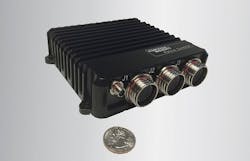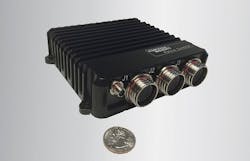Curtiss-Wright debuts ARM-based, low-power, ultra small, rugged mission computer
HELI-EXPO, LOUISVILLE, Ky., 2 March 2016.Curtiss-Wright’s Defense Solutions division has expanded its Parvus family of small-form-factor (SFF) rugged network commercial off-the-shelf (COTS) mission computer subsystems with the Parvus DuraCOR 310 Mission Computer.
The company’s first ultra-small form factor (USFF) mission computer features a low-power, quad-core ARM microprocessor; is well suited to a wide range of applications and platforms that require a size, weight, power, and cost (SWaP-C)-optimized mission computer; and is designed to meet demanding MIL-STD-810G, MIL-STD-461F, MIL-STD-1275D, MIL-STD-704F, and RTCA/DO-160G environmental, power, and electromagnetic interference (EMI) standards.
The company’s latest open standards-based, COTS, miniature mission computer is 75 percent smaller than traditional mission computers and roughly 50 percent lighter than Curtiss-Wright’s previous small, rugged mission computer. This miniature mission computer features an NXP™ Semiconductor (formerly Freescale) i.MX6 ARM processor on an industrial-grade Computer-on-Module (COM) tightly integrated with a Flash solid-state drive (SSD). The super compact unit weighs less than 1.5 pounds, measures only ~39 cubic inches volume (est.), requires less than 10 watts of power, and supports a wide operating temperature range of -40 to +71 degrees Celsius (-40 to +160 degrees Fahrenheit) without fans or active cooling requirements.
“With the introduction of our new Parvus DuraCOR 310 Mission Computer, Curtiss-Wright extends its leadership position as a provider of ultra-small form factor network and computing solutions for SWaP-C sensitive air, ground, and seaborne platforms deployed in harsh environments,” says Lynn Bamford, senior vice president and general manager, Defense Solutions division. “We are proud to be an industry leader in developing next-generation rugged subsystems that meet the unique demands of unmanned platforms, rotorcraft, and other applications where size, weight, power, and cost are a premium.”
The DuraCOR 310 comes with standard vetronics input/output (I/O) interfaces (including CANbus, USB, Ethernet, Serial, DIO, video, and audio). It also supports modification, provided NRE-free at the factory, via two slots for optional add-on Mini-PCIe I/O modules.
The dual Mini-PCIe expansion slots enable mission computer system designers to leverage the broad ecosystem of standards-based industrial Mini-PCIe modules that support avionics databuses (such as MIL-STD-1553 and ARINC 429) in addition to other traditional I/O types. The DuraCOR 310 also features MIL-performance circular connectors.
Software support includes drivers for Linux operating environments. The unit’s ARM processor supports HD-class video acceleration, including OpenGL, OpenCL, and OpenVG.
The DuraCOR 310 complements Curtiss-Wright’s previously announced DuraNET 20-11 miniature Ethernet Switch. The DuraNET 20-11 is an USFF rugged COTS 8-port Gigabit Ethernet (GbE) switch optimized for demanding SWaP-C-constrained vehicle and aircraft platforms exposed to harsh environmental and noisy electrical conditions (e.g. high altitude, extreme shock and vibration, extended temperatures, humidity, dust and water exposure, noisy EMI, and/or dirty power). The unit boasts an ultra-miniature “pocket sized” design with a physical size of roughly 10 cubic inches in volume, 0.50 pounds in weight, and only 5 watts typical power consumption.
Curtiss-Wright Corp. delivers highly engineered, critical function products and services to the commercial, industrial, defense, and energy markets. Building on the heritage of Glenn Curtiss and the Wright brothers, Curtiss-Wright has a long tradition of providing reliable solutions through trusted customer relationships. The company employs approximately 9,000 people worldwide.
You might also like:
Subscribe today to receive all the latest aerospace technology and engineering news, delivered directly to your e-mail inbox twice a week (Tuesdays and Thursdays). Sign upfor your free subscription to the Intelligent Inbox e-newsletter at http://www.intelligent-aerospace.com/subscribe.html.
Connect with Intelligent Aerospace on social media: Twitter (@IntelligentAero), LinkedIn,Google+, and Instagram.
Intelligent Aerospace
Global Aerospace Technology NetworkIntelligent Aerospace, the global aerospace technology network, reports on the latest tools, technologies, and trends of vital importance to aerospace professionals involved in air traffic control, airport operations, satellites and space, and commercial and military avionics on fixed-wing, rotor-wing, and unmanned aircraft throughout the world.


